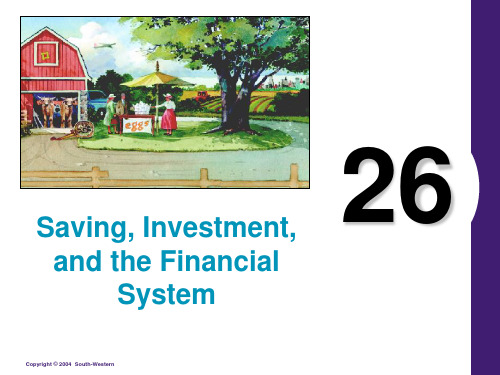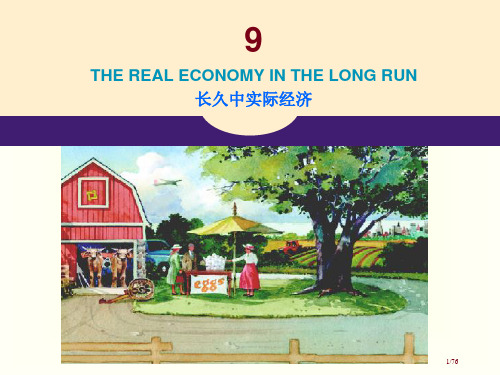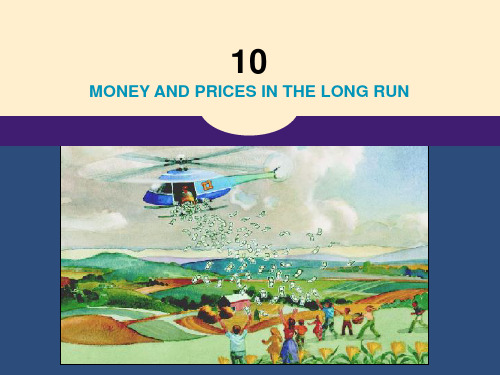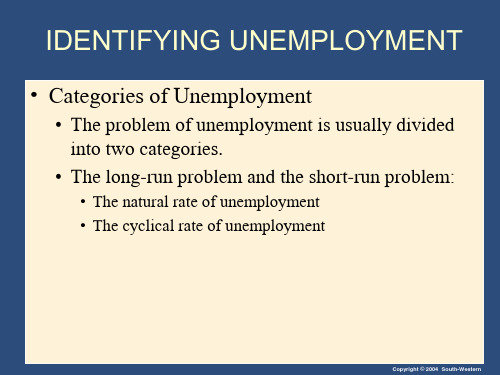曼昆《经济学原理》(宏观经济学分册)英文原版PPT课件
合集下载
曼昆《经济学原理》(宏观经济学分册)英文原版课件——25production-growth

Production and Growth
• In the United States over the past century, average income as measured by real GDP per person has grown by about 2 percent per year.
Copyright © 2004 South-Western
Why Productivity Is So Important • Productivity refers to the amount of goods and
services that a worker can produce from each hour of work.
Copyright © 2004 South-Western
How Productivity Is Determined • The inputs used to produce goods and services
are called the factors of production. • The factors of production directly determine
Copyright © 2004 South-Western
ECONOMIC GROWTH AROUND THE WORLD
• The poorest countries have average levels of income that have not been seen in the United States for many decades.
Copyright © 2004 South-Western
Production and Growth
曼昆《经济学原理》(宏观经济学分册)英文原版PPT课件——26saving_investment

Some Important Identities • Assume a closed economy – one that does not engage in international trade: Y=C+I+G
Copyright © 2004 South-Western
Some Important Identities • Now, subtract C and G from both sides of the equation: Y – C – G =I • The left side of the equation is the total income in the economy after paying for consumption and government purchases and is called national saving, or just saving (S).
Copyright © 2004 South-Western
Financial Intermediaries • Banks
• Banks help create a medium of exchange by allowing people to write checks against their deposits.
Copyright © 2004 South-Western
Financial Intermediaries • Financial intermediaries are financial institutions through which savers can indirectly provide funds to borrowers.
最新曼昆经济学原理第三版宏观分册原版中英文双语PPT课件Chap5课件PPT

Harcourt, Inc. items and derived items copyright © 2001 by Harcourt, Inc.
生产与增长
生产率 是指一个工人一小时生产 的物品与劳务量。 一国的生活水平决定于它的工人 的生产率。
Harcourt, Inc. items and derived items copyright © 2001 by Harcourt, Inc.
Copyright©2004 South-Western
Economic Growth Around the World 世界各国的经济增长
Living standards, as measured by real GDP per person, vary significantly among nations. 人均实际GDP数据表明各国生活水 平差别很大。
Table 1 The Variety of Growth Experiences
Copyright©2004 South-Western
表1. 不同的增长经历
国别
时期
期初人均GDP 期末人均GDP 增长率(每年)
日本
1890~2000
巴西
1900~2000
墨西哥 1900~2000
加拿大 1870~2000
长 的 时 间 隧 道,袅
理第三版宏观分册原版中英文双语P
Production and Growth 生产与增长
Chapter 25
Production and Growth 生产与增长
A country’s standard of living depends on its ability to produce goods and services. 一国的生活水平决定于它生产物品 与劳务的能力。
【精品PPT】曼昆--《经济学原理》宏观经济学分册第六版

Billions
$12,000
$10,000 $8,000 $6,000
真实GDP(基
年是2000年)
$4,000 $2,000
名义GDP
$0 1965 1970 1975 1980 1985 1990 1995 2000 2005
34
23.4.2 GDP平减指数
• GDP平减指数是对总体价格水平的衡量 • 定义:
西方经济学(宏观)
曼昆 《经济学原理》宏观经济学分册第六版
一、什么是宏观经济学?
• 宏观经济学(macroeconomics):研究总体经济变量 的经济学。
• 宏观经济学的主要研究对象:
– 经济增长(economic growth) – 失业(unemployment) – 通货膨胀(inflation) – 国际收支与汇率(balance of payments and exchange rate)
在某一既定时期一个国家内生产的所有最终物品和劳 务的市场价值
最终物品:为终端使用者所准备 中间物品:生产其他物品的一种组成成份或要素 GDP只包括最终产品—生产过程中使用的中间物 品的价值已经包含在最终物品的价值中
一国收入的衡量
15
国内生产总值 (GDP):
在某一既定时期一个国家内生产的所有最终物品和劳 务的市场价值
微观经济学与宏观经济学之间的联系( Linkage )
微观经济学是宏观经济分析的基础( Foundation )
经济作为一个整体的行为(宏观)是以构成经济的个别单位(微观)的行 为为基础的。微观经济学关心资源配置(The allocation of resources);宏观 经济学关心资源利用(The utilization of resources)。
$12,000
$10,000 $8,000 $6,000
真实GDP(基
年是2000年)
$4,000 $2,000
名义GDP
$0 1965 1970 1975 1980 1985 1990 1995 2000 2005
34
23.4.2 GDP平减指数
• GDP平减指数是对总体价格水平的衡量 • 定义:
西方经济学(宏观)
曼昆 《经济学原理》宏观经济学分册第六版
一、什么是宏观经济学?
• 宏观经济学(macroeconomics):研究总体经济变量 的经济学。
• 宏观经济学的主要研究对象:
– 经济增长(economic growth) – 失业(unemployment) – 通货膨胀(inflation) – 国际收支与汇率(balance of payments and exchange rate)
在某一既定时期一个国家内生产的所有最终物品和劳 务的市场价值
最终物品:为终端使用者所准备 中间物品:生产其他物品的一种组成成份或要素 GDP只包括最终产品—生产过程中使用的中间物 品的价值已经包含在最终物品的价值中
一国收入的衡量
15
国内生产总值 (GDP):
在某一既定时期一个国家内生产的所有最终物品和劳 务的市场价值
微观经济学与宏观经济学之间的联系( Linkage )
微观经济学是宏观经济分析的基础( Foundation )
经济作为一个整体的行为(宏观)是以构成经济的个别单位(微观)的行 为为基础的。微观经济学关心资源配置(The allocation of resources);宏观 经济学关心资源利用(The utilization of resources)。
曼昆《经济学原理第三版》宏观分册原版中英文双语Chap25省公开课一等奖全国示范课微课金奖PPT课件

70/ 7 = 10
15/76
Harcourt, Inc. items and derived items copyright © 2001 by Harcourt, Inc.
70规则一个例子
每年利率为7%5000美元投资在后价值翻 一番。
70/ 7 = 10
16/76
Harcourt, Inc. items and derived items copyright © 2001 by Harcourt, Inc.
22/76
Harcourt, Inc. items and derived items copyright © 2001 by Harcourt, Inc.
生产率是怎样决定
物质资本
是生产出来生产要素。
• 它是生产过程投入,也是过去生产过程产出 。
是用于生产物品与劳务设备与建筑物存 量。
• 用于生产或修理汽车工具。 • 用于生产家俱工具。 • 办公楼,学校等等…
Physical Capital
is a produced factor of production.
• It is an input into the production process that in the past was an output from the production process.
17/76
Harcourt, Inc. items and derived items copyright © 2001 by Harcourt, Inc.
Why Productivity Is So Important 为何生产率如此主要
Productivity refers to the quantity of goods and services that a worker can produce from each hour of work. 生产率是指一个工人一小时内所生产 物品与劳务量。
15/76
Harcourt, Inc. items and derived items copyright © 2001 by Harcourt, Inc.
70规则一个例子
每年利率为7%5000美元投资在后价值翻 一番。
70/ 7 = 10
16/76
Harcourt, Inc. items and derived items copyright © 2001 by Harcourt, Inc.
22/76
Harcourt, Inc. items and derived items copyright © 2001 by Harcourt, Inc.
生产率是怎样决定
物质资本
是生产出来生产要素。
• 它是生产过程投入,也是过去生产过程产出 。
是用于生产物品与劳务设备与建筑物存 量。
• 用于生产或修理汽车工具。 • 用于生产家俱工具。 • 办公楼,学校等等…
Physical Capital
is a produced factor of production.
• It is an input into the production process that in the past was an output from the production process.
17/76
Harcourt, Inc. items and derived items copyright © 2001 by Harcourt, Inc.
Why Productivity Is So Important 为何生产率如此主要
Productivity refers to the quantity of goods and services that a worker can produce from each hour of work. 生产率是指一个工人一小时内所生产 物品与劳务量。
曼昆《经济学原理》(宏观经济学分册)英文原版PPT课件——29monetary_system

Copyright © 2004 South-Western
The Functions of Money • Unit of Account
• A unit of account is the yardstick people use to post prices and record debts.
Copyright © 2004 South-Western
The Fed’s Organization • The Federal Reserve System is made up of the Federal Reserve Board in Washington, D.C., and twelve regional Federal Reserve Banks.
The Fed’s Organization • The Federal Reserve Banks
• The New York Fed implements some of the Fed’s most important policy decisions.
pyright © 2004 South-Western
• That is $2,734 in currency per adult.
• Who is holding all this currency?
• Currency held abroad • Currency held by illegal entities
Copyright © 2004 South-Western
Copyright © 2004 South-Western
The Fed’s Organization • The Federal Open Market Committee (FOMC) is made up of the following voting members:
曼昆经济学原理宏观经济学分册英文原版PPT课件28unemployment

How Is Unemployment Measured?
Unemployment is measured by the Bureau of Labor Statistics (BLS). It surveys 60,000 randomly selected households every month. The survey is called the Current Population Survey.
How Is Unemployment Measured?
A person is unemployed if he or she is on temporary layoff, is looking for a job, or is waiting for the start date of a new job.
How Is Unemployment Measured?
Based on the answers to the survey questions, the BLS places each adult into one of three categories: Employed Unemployed Not in the labor force
JOB SEARCH
Job search the process by which workers find appropriate jobs given their tastes and skills. results from the fact that it takes time for qualified individuals to be matched with appropriate jobs.
Why Are There Always Some People Unemployed?
Unemployment is measured by the Bureau of Labor Statistics (BLS). It surveys 60,000 randomly selected households every month. The survey is called the Current Population Survey.
How Is Unemployment Measured?
A person is unemployed if he or she is on temporary layoff, is looking for a job, or is waiting for the start date of a new job.
How Is Unemployment Measured?
Based on the answers to the survey questions, the BLS places each adult into one of three categories: Employed Unemployed Not in the labor force
JOB SEARCH
Job search the process by which workers find appropriate jobs given their tastes and skills. results from the fact that it takes time for qualified individuals to be matched with appropriate jobs.
Why Are There Always Some People Unemployed?
最新曼昆《经济学原理第三版》宏观分册原版中英文双语PPT课件Chap6PPT课件

• 提出、通过和实施一项重要的财政政策 变动需要好几年的时间。
Copyright © 2004 South-Western
Con: Policymakers should not try to stabilize the economy
• All too often policymakers can inadvertently exacerbate rather than mitigate the magnitude of economic fluctuations.
Copyright © 2004 South-Western
反对:决策者不应该努力稳定经济
• 在需要采取行动到货币政策能发挥作用之 间,货币政策对经济的作用要有一个相当 长而且不可预见的时滞。
• 许多研究表明,在作出货币政策变动的6个 月之内,这种变动对总需求的影响很小。
Copyright © 2004 South-Western
3.Should the central bank aim for zero inflation?
4.Should the government balance its budget? 5.Should the tax laws be reformed to encourage
saving?
Copyright © 2004 South-Western
Con: Policymakers should not try to stabilize the economy
• Fiscal policy works with a lag because of the long political process that governs changes in spending and taxes.
Copyright © 2004 South-Western
Con: Policymakers should not try to stabilize the economy
• All too often policymakers can inadvertently exacerbate rather than mitigate the magnitude of economic fluctuations.
Copyright © 2004 South-Western
反对:决策者不应该努力稳定经济
• 在需要采取行动到货币政策能发挥作用之 间,货币政策对经济的作用要有一个相当 长而且不可预见的时滞。
• 许多研究表明,在作出货币政策变动的6个 月之内,这种变动对总需求的影响很小。
Copyright © 2004 South-Western
3.Should the central bank aim for zero inflation?
4.Should the government balance its budget? 5.Should the tax laws be reformed to encourage
saving?
Copyright © 2004 South-Western
Con: Policymakers should not try to stabilize the economy
• Fiscal policy works with a lag because of the long political process that governs changes in spending and taxes.
- 1、下载文档前请自行甄别文档内容的完整性,平台不提供额外的编辑、内容补充、找答案等附加服务。
- 2、"仅部分预览"的文档,不可在线预览部分如存在完整性等问题,可反馈申请退款(可完整预览的文档不适用该条件!)。
- 3、如文档侵犯您的权益,请联系客服反馈,我们会尽快为您处理(人工客服工作时间:9:00-18:30)。
© 2007 Thomson South-Western
THE COMPONENTS OF GDP • GDP includes all items produced in the economy and sold legally n markets. • What Is Not Counted in GDP?
– Every transaction has a buyer and a seller. – Every dollar of spending by some buyer is a dollar of income for some seller.
© 2007 Thomson South-Western
Y = C + I + G + NX
© 2007 Thomson South-Western
THE COMPONENTS OF GDP • Consumption (C):
• The spending by households on goods and services, with the exception of purchases of new housing. • Investment (I):
© 2007 Thomson South-Western
Table 2 Real and Nominal GDP
© 2007 Thomson South-Western
Table 2 Real and Nominal GDP
© 2007 Thomson South-Western
Table 2 Real and Nominal GDP
• “. . . Final . . .” – It records only the value of final goods, not intermediate goods (the value is counted only once).
• “. . . Goods and Services . . .” – It includes both tangible goods (food, clothing, cars) and intangible services (haircuts, housecleaning, doctor visits).
goods or services. • Net Exports (NX):
– Exports minus imports.
© 2007 Thomson South-Western
Table 1 GDP and Its Components
© 2007 Thomson South-Western
GDP and Its Components (2004)
© 2007 Thomson South-Western
REAL VERSUS NOMINAL GDP • An accurate view of the economy requires adjusting nominal to real GDP by using the GDP deflator.
Investment 16%
Government Purchases 15%
Net Exports -5 %
Consumption 70%
© 2007 Thomson South-Western
REAL VERSUS NOMINAL GDP • Nominal GDP values the production of goods and services at current prices. • Real GDP values the production of goods and services at constant prices.
© 2007 Thomson South-Western
The GDP Deflator • The GDP deflator is a measure of the price level calculated as the ratio of nominal GDP to real GDP times
Figure 1 The Circular-Flow Diagram
MARKETS
Revenue
FOR
Spending
GOODS AND SERVICES
Goods and services
•Firms sell •Households
buy
Goods and services
sold
bought
one another in markets. Macroeconomics is the study of the economy as a whole. Its goal is to explain the economic changes that affect
many households, firms, and markets at once.
time.
© 2007 Thomson South-Western
THE MEASUREMENT OF GROSS DOMESTIC PRODUCT • The equality of income and expenditure can be illustrated with the circular-flow diagram.
FIRMS •Produce and sell goods and services •Hire and use factors of production
HOUSEHOLDS •Buy and consume goods and services •Own and sell factors of production
= Flow of dollars
© 2007 Thomson South-Western
THE MEASUREMENT OF GROSS DOMESTIC PRODUCT • Gross domestic product (GDP) is a measure of the income and expenditures of an economy. • GDP is the total market value of all final goods and services produced within a country in a given period of
Factors of production
MARKETS FOR
Labor, land, and capital
FACTORS OF PRODUCTION
Wages, rent,
•Households sell Income
and profit
•Firms buy
= Flow of inputs
and outputs
everyone in the economy is earning.
© 2007 Thomson South-Western
THE ECONOMY’S INCOME AND EXPENDITURE • For an economy as a whole, income must equal expenditure because:
• The spending on capital equipment, inventories, and structures, including new housing.
© 2007 Thomson South-Western
THE COMPONENTS OF GDP • Government Purchases (G):
曼昆《经济学原理》(宏观经济学分册)英文 原版PPT课件
Measuring a Nation’s Income Microeconomics is the study of how individual households and firms make decisions and how they interact with
© 2007 Thomson South-Western
THE MEASUREMENT OF GROSS DOMESTIC PRODUCT
• “GDP is the Market Value . . .” – Output is valued at market prices.
• “. . . Of All. . .” – Includes all items produced in the economy and legally sold in markets
© 2007 Thomson South-Western
THE ECONOMY’S INCOME AND EXPENDITURE • When judging whether the economy is doing well or poorly, it is natural to look at the total income that
• “ . . . Within a Country . . .” – It measures the value of production within the geographic confines of a country.
• “. . . In a Given Period of Time.” – It measures the value of production that takes place within a specific interval of time, usually a year or a quarter (three months).
© 2007 Thomson South-Western
Measuring a Nation’s Income Macroeconomics answers questions like the following:
THE COMPONENTS OF GDP • GDP includes all items produced in the economy and sold legally n markets. • What Is Not Counted in GDP?
– Every transaction has a buyer and a seller. – Every dollar of spending by some buyer is a dollar of income for some seller.
© 2007 Thomson South-Western
Y = C + I + G + NX
© 2007 Thomson South-Western
THE COMPONENTS OF GDP • Consumption (C):
• The spending by households on goods and services, with the exception of purchases of new housing. • Investment (I):
© 2007 Thomson South-Western
Table 2 Real and Nominal GDP
© 2007 Thomson South-Western
Table 2 Real and Nominal GDP
© 2007 Thomson South-Western
Table 2 Real and Nominal GDP
• “. . . Final . . .” – It records only the value of final goods, not intermediate goods (the value is counted only once).
• “. . . Goods and Services . . .” – It includes both tangible goods (food, clothing, cars) and intangible services (haircuts, housecleaning, doctor visits).
goods or services. • Net Exports (NX):
– Exports minus imports.
© 2007 Thomson South-Western
Table 1 GDP and Its Components
© 2007 Thomson South-Western
GDP and Its Components (2004)
© 2007 Thomson South-Western
REAL VERSUS NOMINAL GDP • An accurate view of the economy requires adjusting nominal to real GDP by using the GDP deflator.
Investment 16%
Government Purchases 15%
Net Exports -5 %
Consumption 70%
© 2007 Thomson South-Western
REAL VERSUS NOMINAL GDP • Nominal GDP values the production of goods and services at current prices. • Real GDP values the production of goods and services at constant prices.
© 2007 Thomson South-Western
The GDP Deflator • The GDP deflator is a measure of the price level calculated as the ratio of nominal GDP to real GDP times
Figure 1 The Circular-Flow Diagram
MARKETS
Revenue
FOR
Spending
GOODS AND SERVICES
Goods and services
•Firms sell •Households
buy
Goods and services
sold
bought
one another in markets. Macroeconomics is the study of the economy as a whole. Its goal is to explain the economic changes that affect
many households, firms, and markets at once.
time.
© 2007 Thomson South-Western
THE MEASUREMENT OF GROSS DOMESTIC PRODUCT • The equality of income and expenditure can be illustrated with the circular-flow diagram.
FIRMS •Produce and sell goods and services •Hire and use factors of production
HOUSEHOLDS •Buy and consume goods and services •Own and sell factors of production
= Flow of dollars
© 2007 Thomson South-Western
THE MEASUREMENT OF GROSS DOMESTIC PRODUCT • Gross domestic product (GDP) is a measure of the income and expenditures of an economy. • GDP is the total market value of all final goods and services produced within a country in a given period of
Factors of production
MARKETS FOR
Labor, land, and capital
FACTORS OF PRODUCTION
Wages, rent,
•Households sell Income
and profit
•Firms buy
= Flow of inputs
and outputs
everyone in the economy is earning.
© 2007 Thomson South-Western
THE ECONOMY’S INCOME AND EXPENDITURE • For an economy as a whole, income must equal expenditure because:
• The spending on capital equipment, inventories, and structures, including new housing.
© 2007 Thomson South-Western
THE COMPONENTS OF GDP • Government Purchases (G):
曼昆《经济学原理》(宏观经济学分册)英文 原版PPT课件
Measuring a Nation’s Income Microeconomics is the study of how individual households and firms make decisions and how they interact with
© 2007 Thomson South-Western
THE MEASUREMENT OF GROSS DOMESTIC PRODUCT
• “GDP is the Market Value . . .” – Output is valued at market prices.
• “. . . Of All. . .” – Includes all items produced in the economy and legally sold in markets
© 2007 Thomson South-Western
THE ECONOMY’S INCOME AND EXPENDITURE • When judging whether the economy is doing well or poorly, it is natural to look at the total income that
• “ . . . Within a Country . . .” – It measures the value of production within the geographic confines of a country.
• “. . . In a Given Period of Time.” – It measures the value of production that takes place within a specific interval of time, usually a year or a quarter (three months).
© 2007 Thomson South-Western
Measuring a Nation’s Income Macroeconomics answers questions like the following:
